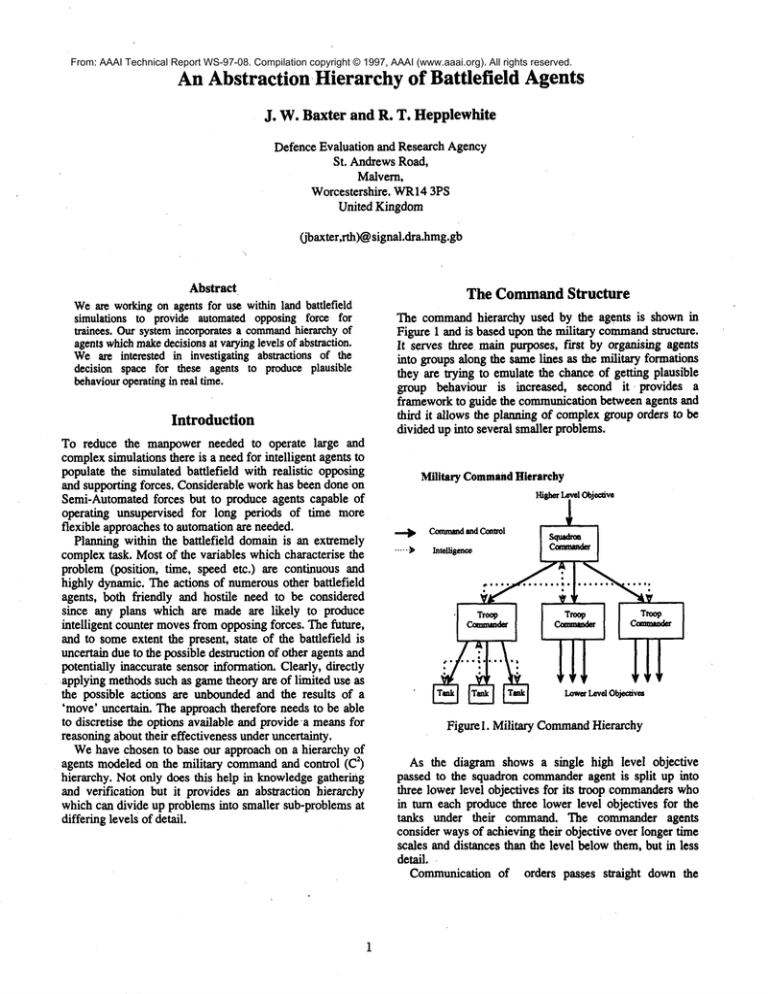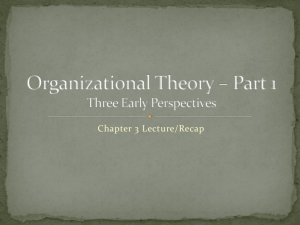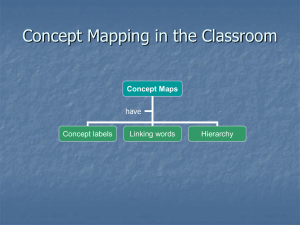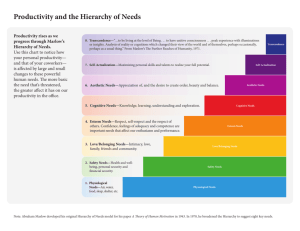
From: AAAI Technical Report WS-97-08. Compilation copyright © 1997, AAAI (www.aaai.org). All rights reserved.
An Abstraction Hierarchyof Battlefield Agents
J. W. Baxter and R. T. Hepplewhite
Defence Evaluation and Research Agency
St. AndrewsRoad,
Malvern,
Worcestershire. WR143PS
United Kingdom
0baxter,rth)@signal.dra.hmg.gb
Abstract
Weare workingon agents for use within land battlefield
simulations to provide automated opposing force for
trainees. Our systemincorporates a command
hierarchy of
agentswhichmakedecisionsat varyinglevels of abstraction.
Weare interested in investigating abstractions of the
decision space for these agents to produce plausible
behaviouroperatingin real time.
Introduction
To reduce the manpower needed to operate large and
complexsimulations there is a need for intelligent agents to
populate the simulated battlefield with realistic opposing
and supporting forces. Considerable work has been done on
Semi-Automatedforces but to produce agents capable of
operating unsupervised for long periods of time more
flexible approachesto automationare needed.
Planning within the battlefield domainis an extremely
complextask. Most of the variables which characterise the
problem (position, time, speed etc.) are continuous and
highly dynamic. The actions of numerousother battlefield
agents, both friendly and hostile need to be considered
since any plans which are made are likely to produce
intelligent counter movesfrom opposing forces. The future,
and to someextent the present, state of the battlefield is
uncertain due to the possible destruction of other agents and
potentially inaccurate sensor information. Clearly, directly
applying methodssuch as gametheory are of limited use as
the possible actions are unboundedand the results of a
’move’ uncertain. The approach therefore needs to be able
to discretise the options available and provide a meansfor
reasoning about their effectiveness under uncertainty.
Wehave chosen to base our approach on a hierarchy of
2)
agents modeled on the military commandand control (C
hierarchy. Not only does this help in knowledgegathering
and verification but it provides an abstraction hierarchy
which can divide up problems into smaller sub-problems at
differing levels of detail.
The CommandStructure
The commandhierarchy used by the agents is shown in
Figure 1 and is based upon the military command
structure.
It serves three main purposes, first by organising agents
into groups along the same lines as the military formations
they are trying to emulate the chance of getting plausible
group behaviour is increased, second it provides a
frameworkto guide the communicationbetween agents and
third it allows the planning of complexgroup orders to be
divided up into several smaller problems.
Military Command
Hierarchy
Hish~T Objective
Comnmnd
m~lCcmrol
ImeUigence
Do.to
*o..
Troop
Figure 1. Military Command
Hierarchy
As the diagram shows a single high level objective
passed to the squadron commanderagent is split up into
three lower level objectives for its troop commanderswho
in turn each produce three lower level objectives for the
tanks under their command. The commander agents
consider waysof achieving their objective over longer time
scales and distances than the level below them, but in less
detail.
Communication of orders passes straight down the
hierarchy while intelligence informationis sharedbetween
peers and communicated
to superiors and therefore flows
both across andup the hierarchy.
Command
roles
The commanderagents must carry out a number of
functions. Theyare responsible for gathering information
about their ownsituation and passing it up the command
chain to their superior and to their peers. Troop
commanders
for instance relay informationto the Squadron
commander,and the commandersof other troops in the
squadron,aboutthe positionof their troop.
The commanders
are responsible for giving orders to
their subordinatesto achievethe orders givento them.They
are also required to monitorthe progress of the group
towardsachievingthose orders and report to their superior
once they have been completed.To fulfill this role they
needto be able to reasonabout howtheir local situation
affects the orders they haveand plan to achievethem.They
also have to ensure that their subordinates knowenough
about the orders given to the group so that they can take
over as commandersin the event of the commander’s
demise.
Discussion
Webelieve that the command
hierarchy provides a natural
wayof splitting up the problem of controlling large
numbersof simulated entities. All agents have to make
decisions on the uncertain informationthey haveabout the
state of the worldbut the size of the problemspaceand the
needto operate in real time makesthe use of meaningful
abstractions vital. So far in our workwehaveexploredthe
use of a state spaceabstraction, searchingfor plans in the
space of potential actions for individual tanks, and
abstraction of the terrain modelfor anytimeroute planning
andlocating defensivepositions. Thesimulatedbattlefield
domainis a challenging one and as we investigate the
operation of agents higher up the command
chain decisions
will be madeat an increasinglyabstract level.
Thesedecisions, however,will need to be executedby
other agents in the ’real’ world whereany faults in the
abstraction will soonbecomeapparent.
© British CrownCopyright 1997 / DERA
Reproducedwith the permission of the controller of Her
BritannicMajesty’sStationeryOffice.
2




